The industry needs degreed professionals, but it needs even more mid- and lower-level photonics technicians. K-12 outreach and hands-on programs are helping to fill the gap.
JAMES SCHLETT, CONTRIBUTING EDITOR
Earlier this year, at a major recruitment event at the
University of Arizona’s Wyant College of Optical Sciences (OSC), the job openings listed outnumbered students in attendance. This imbalance exemplifies the immense pressure STEM programs across the country face in meeting photonics industry workforce demands.
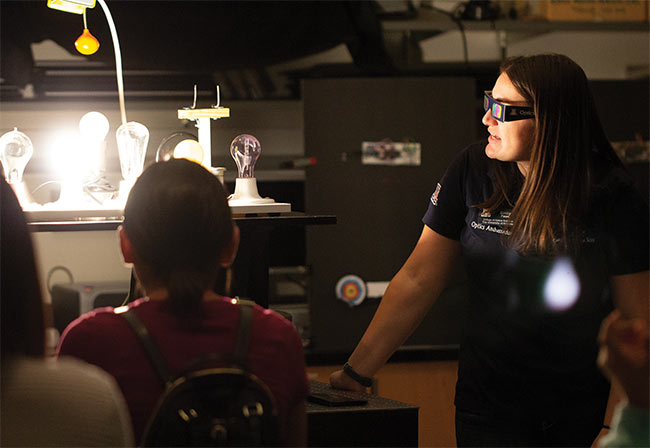
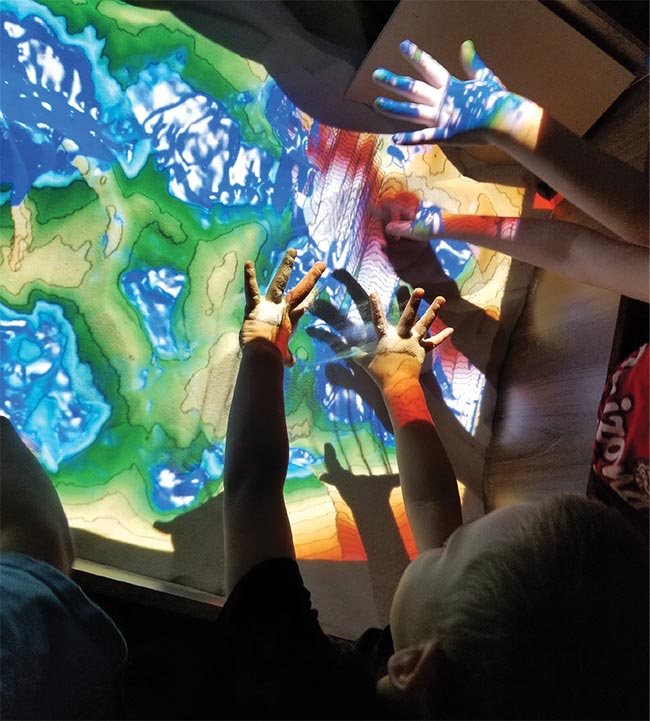
Laser Fun Day and Expect Academic Success in STEM (EASIS) Optical Engineering Summer Camp activities at the Wyant College of Optical Sciences. Courtesy of University of Arizona.
“Employers have a seemingly endless demand for STEM graduates across the B.S./M.S./Ph.D. level,” said Justin Walker, OSC’s associate dean for business development and administration.
Technology companies and the U.S. Department of Defense (DOD) are competing for graduates in optical sciences, Walker said, and demand from the tech sector in northern California and Washington state has been accelerating rapidly because of developments in imaging, cloud-based architectures, and AR/VR technology.
Two-thirds of the 101 optics and optical sciences degrees that OSC awarded in 2020 were at the graduate level, with 43 master’s and 23 doctorates, according to the Integrated Postsecondary Education Data System (IPEDS). And even as the U.S. industry wrestles with the challenges of hiring highly skilled professionals, it faces an even larger deficit of middle- and lower-skilled photonics specialists.
Optics technicians in demand
“If you don’t have precision optics technicians to meet the demand, then all of these industries will suffer,” said Josanne DeNatale, national marketing manager for the American Center for Optics Manufacturing (AmeriCOM). “For every optics engineer focused on manufacturing innovation, a minimum of 10 optics technicians are needed to bring the innovation to market.”
‘Ironically, advanced mathematics is not an essential skill of a photonics technician, and [yet it] is one of the most significant deterrents to choosing photonics as a career.’
— Natalia Chekhovskaya, LASER-TEC program manager, Indian River State College
AmeriCOM runs the Defense Precision Optics Workforce Development and Technology Ecosystem Project, a $34 million DOD-funded public-private partnership.
A 2021 workforce study supported by AIM Photonics predicted that the number of middle- and lower-skilled positions in the U.S. would grow from 58,000 today to nearly 85,000 by the end of the decade. After considering retirements and separations, the study’s authors estimated annual U.S. job openings of 3500 for new middle-skilled personnel, including 2200 engineering technicians and 5500 lower-skilled photonics technicians1.
Job titles associated with photonics technicians include certified laser techs, optical engineering techs, and precision optics techs. They build, install, test, or maintain optical or fiber optic equipment, according to the study.
To meet these projections, the study’s authors estimated that the U.S. will need 140 training programs for middle-skilled workers and 180 certificate programs for lower-skilled workers. But only 13 colleges nationwide offer full laser, optics, and/or photonics degree programs, and seven offer specialization or certification
programs, according to Natalia Chekhovskaya, the program manager for LASER-TEC at Indian River State College in Fort Pierce, Fla. However, 44 institutions have partnered with the Optics and Photonics College Network, which is administered by LASER-TEC.
“As the demand for skilled optics technicians is increasing, the supply of this skilled workforce is decreasing. The existing training capacity within the U.S. community college system is inadequate to train replacement workers or to grow the workforce to support future needs. Unfortunately, many tech industries face a workforce shortfall and may compete for talent with each other,” DeNatale said.


Indian River State College students work on projects during a course on Lasers, Systems, and Applications (top) and in the Introduction to Photonics course laboratory (bottom). Courtesy of LASER-TEC.
‘For every optics engineer focused on manufacturing innovation, a minimum of 10 optics technicians are needed to bring the innovation to market.’ — Josanne DeNatale, national marketing manager, AmeriCOM
The DOD has tasked AmeriCOM with increasing the nation’s output of skilled optics technicians to about 800 by 2025. In 2020, according to the IPEDS data, a total of 395 degrees were awarded in the fields of laser and optical engineering (130), laser and optical technology (49), optics and optical sciences (187), and electronic engineering technology (29). About two-thirds of those degrees were at the graduate level. Indian River is the only college that offers an electronic engineering technology program with a photonics concentration. The college awarded an additional 119 certificates below the baccalaureate level — 104 in laser and optical technology and 15 in electronic engineering technology. The IPEDS data does not specify the number of other engineering and engineering technology programs that address but do not concentrate on photonics.
Filling the talent pipeline
The AIM Photonics workforce study identified five hard-to-fill occupations with moderate to strong growth prospects: photonics technicians, electrical/electronic engineering technicians, computer-controlled (CNC) machine tool operators, optical equipment operators, and semiconductor processors.

A student at Sussex County Community College (SCCC) measures the surface roughness (texture) of an optic using a ZYGO NewView 3D optical surface profiler. Courtesy of Thorlabs.
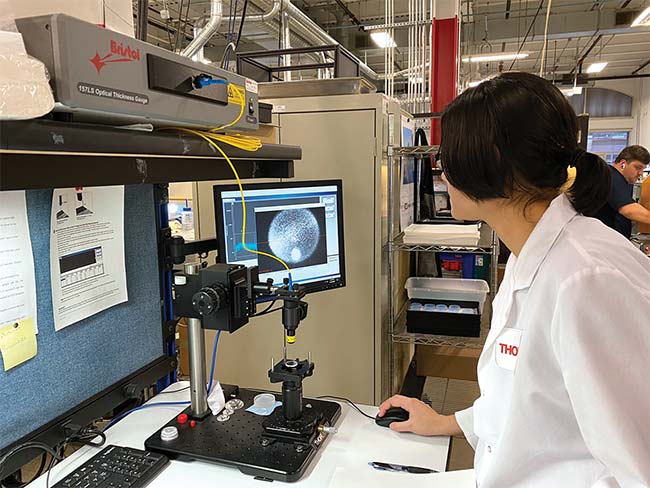
An SCCC student measures the thickness of an alignment window using a cutting-edge noncontact thickness gauge.
Courtesy of Thorlabs.
To generate enough qualified workers
to fill these jobs, AmeriCOM and its partners are largely focused on attracting more students into the industry’s talent pipeline. The initiative includes prioritizing in-demand STEM skills — not necessarily advanced mathematics — rolling out introductory courses that attract existing students not familiar with photonics, targeting populations underrepresented in optics occupations, and expanding outreach at the K-12 level.
“While strong math skills may be helpful, they are not a deal-breaking requirement for the precision optics manufacturing industry,” DeNatale said.
Chekhovskaya agreed that, for technicians, mastery of algebra concepts and applications in photonics and optics is
adequate. “Ironically, advanced mathematics is not an essential skill of a
photonics technician, and [yet it] is one
of the most significant deterrents to choosing photonics as a career,” she said.
Also, community college photonics courses that teach the practical applications of photonics technologies but lack calculus are not usually transferrable to four-year degrees. Monroe Community College in Rochester, N.Y., has technician training programs as well as 2+2 programs in which, after two years, students can transfer to the University of Rochester’s Institute of Optics, Rochester Institute of Technology’s Imaging Science program, or the University of Arizona’s College of Optical Sciences.
Additionally, in 2020, the DOD’s Manufacturing Technology Program awarded Massachusetts a $3.2 million grant to develop a manufacturing technician program that could serve as a model for the nation. The MassBridge program trains technicians in photonics and other advanced manufacturing industries by forming and piloting curricula at vocational and academic high schools and community colleges statewide.
Many of AmeriCOM’s college partners want to create accelerated photonics programming. Whereas one-year certificates and two-year associate degrees have been the norm, some colleges are developing accelerated 20-week programs and two- to three-week micro-credential programs that focus on a specific aspect of the manufacturing process, DeNatale said.
Outside the 2+2 programs, technicians may encounter challenges when skilling
up. “Technician training programs are not very compatible with science and engineering programs. The math [and other requirements are] very different, and students who get an A.S. technician degree have to take a lot of additional coursework if they decide to continue
to the B.S.,” said David Hogan, dean
of CREOL, The College of Optics and Photonics at the University of Central Florida (UCF) in Orlando.
CREOL has made substantial investments to improve its teaching laboratories, senior capstone design projects, and its introductory design class for freshmen or sophomores.
“Our initiative [is intended to] prepare students in the practical aspects of optics and photonics,” Hogan said. “We want them to be able to build things.” Because many students are not aware of CREOL when they enter UCF, he said, an exciting introductory design course becomes a “great recruiting tool.”
Industry partnerships are crucial to strong optics and photonics programs. The programs at Indian River, Monroe, Central Carolina Community College, Indian Hills Community College, and Springfield Technical Community College are each supported by an estimated 10 to 20 companies, Chekhovskaya said. For example, at Indian River, the fiber optics company Precision Contracting Services has built a long-haul fiber link laboratory at the college. DeNatale said other companies supporting precision
optics programs at colleges include L3Harris, Corning, Optimax, Sydor
Optics, and Thorlabs.
Sparking excitement in K-12
The pandemic only exasperated the multigenerational decline in interest in manufacturing careers. After the pandemic limited face-to-face interactions for K-12 and college students, colleges such as CREOL saw declines in enrollment that are only now reversing, Hogan said.
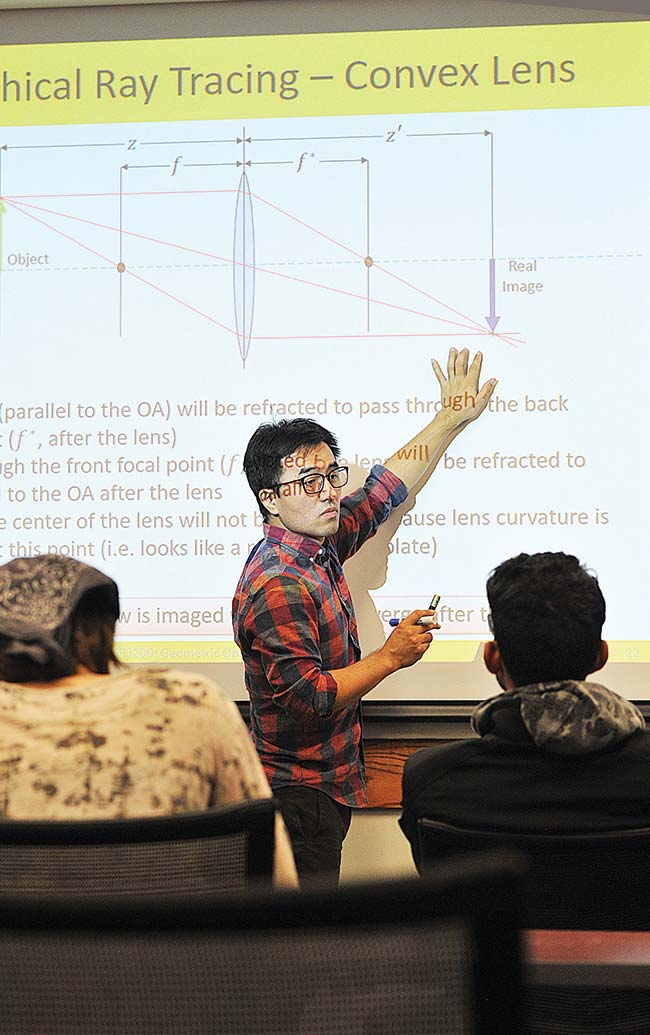
Assistant professor Kyu Young Han teaches optics and photonics at CREOL, The College of Optics and Photonics at the University of Central Florida.
Courtesy of University of Central Florida.
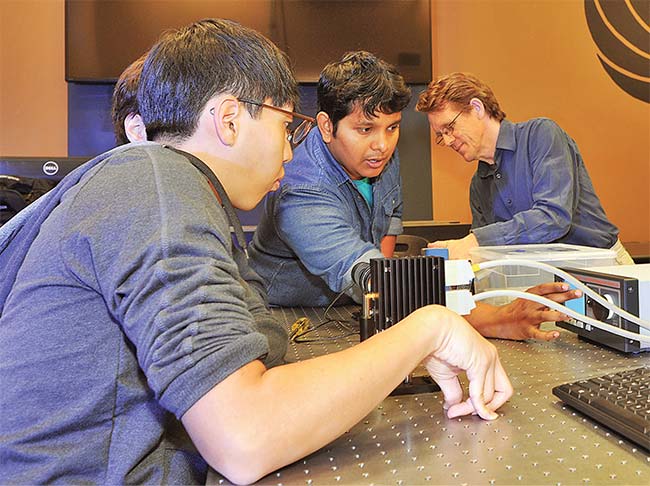
Students work in a CREOL lab. Courtesy of University of Central Florida.

Lowell High School students participate in SparkAlpha Industry Day at Mycronic in Tewksbury, Mass.. Courtesy of SparkAlpha.
To create excitement for optics and photonics, AmeriCOM has launched a strategic marketing campaign targeting audiences from middle school children to college-bound students, to adults seeking a career change. “Many people — including artists, musicians, gamers, chefs, mechanics, and athletes — make excellent optics technicians, but they are not aware the field exists,” DeNatale said. The campaign also aims to recruit students into optics technician certificate and degree programs at select colleges in the optics ecosystem.
In recent years, LASER-TEC has similarly hosted thousands of isolated events that have been attended by nearly 40,000 students, family members, teachers, faculty, and others. However, these events only increased public awareness, not enrollment, in college photonics programs, Chekhovskaya said. The events delivered a short-term, unsustained interest in photonics technologies, without promoting access to photonics training programs for historically underrepresented and underserved demographic groups.
In partnership with the Children’s Services Council of St. Lucie County and Indian River State College, LASER-TEC now offers an eight-week, full-day summer camp called the Emerging Technologies Summer Program. In December 2021, LASER-TEC also launched a Women in Photonics Technologies network consisting of female students who are currently attending college photonics programs, program faculty members, and established professionals in the industry.
“Reevaluation made us pivot our strategy and move to offer long-term, highly engaging hands-on student programs — explicitly tuned to develop skills and knowledge in optics, photonics, and other related technologies — which nurture students’ curiosity, interest, and buy-in,” Chekhovskaya said. These programs require a lot of resources — including people, time, facilities, and funding — and cost an average of more than $2500 per student per program.
SparkAlpha, a program run by the nonprofit Spark Photonics Foundation in Waltham, Mass., introduces middle and high school students to education and career pathways in photonics. The program encourages the students to develop photonics-based concepts, create business plans, and then pitch them to a panel of judges.
In May, Massachusetts awarded SparkAlpha a $279,681 STEM curriculum grant to support work at Western New England University to introduce optics and photonics concepts into math and science curricula in grades six through 12 across the state. The initiative also offers professional development for teachers and raises awareness among parents.
“We find that the students are amazed that this technology is so prevalent and they’ve never heard of it,” said Kevin McComber, Spark Photonics’ co-founder and CEO.
Reference
1. R. Kirchain et al. (2021). Preparing the advanced manufacturing workforce: a study of occupation and skills demand in the
photonics industry, www.aimphotonics.com/s/Photonics-Workforce.pdf.